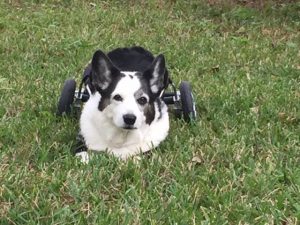-Bobbie Mayer
Degenerative Myelopathy (DM) is a neurological disease that occurs in a large number of dog breeds, including both Pembroke and (to a lesser extent) Cardigan Welsh corgis. The average age of onset in Pembroke Welsh corgis is about 11 years, with 8 years being the youngest (it does occur at earlier ages in some breeds.) This appears to be similar in Cardigans but insufficient Cardis with DM have been studied for us to know for sure.
The diagnosis of DM was discussed in the article on DM and IVDD in corgis so I do not want to repeat it here, although I will discuss the signs that appear initially and as the disease progresses.
DM is similar to ALS in humans but unlike ALS, progresses in a mostly predictable way. It starts with slight loss of proprioception (the ability to locate where a limb is in space) in the back legs, and proceeds to gradual loss of movement in the back legs, then the trunk, and eventually the front legs. If allowed to progress to a terminal stage it will cause death by asphyxiation. This process takes about 3 ½-4 years. Because of the late onset of DM, though, many dogs will die of other causes before this point, and others will be euthanized when quality of life has become too poor.
It sounds really horrible and sad, and on the one hand, it is. It’s a fatal disease and disability continues to increase throughout the progress of the disease. It’s difficult for the owner-caregiver to observe and manage. But on the other hand, much of the remaining life of a corgi diagnosed with DM can be made very good with a little effort and adaptation.
So what do you do after a diagnosis of DM?
First of all, at this writing in July 2017, there are no effective therapies. Physical therapy and other exercise will help maintain health and strength but despite PT the disease will progress. For example, where water treadmill may help a corgi recovering from IVDD to walk again, the corgi with DM will still end up unable to walk. It’s unclear whether PT can put this off significantly. There are no supplements or medications that have been shown to slow the disease. Research on DM is ongoing, though, and at this time a clinical trial is proceeding to test new therapies.

At first, when your corgi is just wobbly, you can help by increasing traction. What happens is that if your corgi’s foot slips, he can’t tell that has happened, due to his proprioceptive loss, so he wobbles or falls. PT may help temporarily with proprioception, but what really helps is to prevent the slip. This can be accomplished with runners on slick floors, walking on grass, dirt, or pavement outside, or things such as Pawz boots or ToeGrips for indoor and outdoor use. You may also want to get a lifting harness to help him get up from lying down or steadying him if he is having trouble. This is also a good time to start researching carts and to measure your dog, since that’s easier while he is still standing. You can find info and measuring tips at http://corgiaid.org/wp/cart/
Within about 6-12 months the DM corgi is usually ready for a cart. It’s a good idea to get one before your corgi stops walking and start getting him used to using it. You can feed him in it at first, after making sure it fits, to make positive associations with the cart. Playing games like find the cookie (or carrot or toy) in the cart also help. He will gradually begin to need it. I used to carry Merlin’s cart on our walks and when I heard his toes start dragging on the sidewalk, he went into the cart. At first, that was after three blocks, but then two, then one, and by the time he could not walk without the cart, he was using it like a pro.
Corgis that know how to do things like heeling, herding, tracking, rally, chasing a ball, and nosework, among others, do very well if you simply let them transition to these activities in a cart.
Keep an eye on feet at this point- it is very easy for a corgi who is starting to go down or using a cart to injure the toes and tops of his feet by dragging them.
Sometime after your corgi is unable to walk without a cart, he may start having troubles urinating. This is more common in males than in females, but some females also have difficulty or stop being able to go on their own. You can learn to express urine fairly easily, and if leaks persist at night or inside, use a diaper or belly band with a pad. Some people prefer just to use absorbent bedding at night. Yes, this sounds like a horrible thing and a lot of trouble but it happens gradually and you adjust.
Your dog will appear to plateau after he goes down in back, but the disease is steadily progressing up the spinal cord. Eventually it affects abdominal muscles and diaphragmatic muscles, and his breathing may change and his back sag a bit. At this point he may also start lying down or sagging in his cart. Carts can be counterbalanced at this point or front wheels added. About this time you may want to get a dog stroller to help out with walks. As I’d once carried the cart while Merlin walked on his own, later on, I pushed an empty stroller until he was ready to quit walking in the four-wheel cart and ride home in the stroller. Merlin enjoyed his stroller- I think the higher view suited him very well!
Ultimately, if your dog lives long enough, the front legs also start to knuckle. Some people have addressed this by putting front boots on, others have made a platform for the feet so their dog can still at least be pushed or pulled in the cart. Being upright in the cart is healthy so at least part of the day it is good to still use the cart, and it is very useful for expressing. At this stage the owner needs to make sure water is always in reach since the corgi cannot move much, and monitor for quality of life.
It’s also very important to remember that not everything that goes on with a DM corgi is because of DM. They are senior dogs and get other diseases- cancer, heart disease, kidney disease, liver disease, and so on. Any change not obviously part of the DM progression warrants a vet visit. Because DM hits corgis fairly late, many will succumb to other causes of death, but some of these things can be treated if caught early. For example, Merlin quit eating about April of 2010. It turned out to be his seizure meds affecting his liver, and a change of medications resolved the problem, giving him 8 more months of life.

All of this will sound very difficult to those who haven’t experienced it, so I want to talk about some of the things that have contributed to quality of life. Bosun, a Pembroke with DM, completed a Nosework title in his two-wheel cart. Merlin, Lucky, and Helen all went camping with their families. Jack went herding and tracking. Stretch completed Freestyle and Trick Dog titles. Other corgis have wheeled and been wheeled in parades, attended picnics, gone to the beach, and, in other words, enjoyed being dogs and part of families as long as they could.
Deciding when a DM corgi’s quality of life has decreased too much can be a difficult thing. Contrary to how it happens with most diseases, the corgi may not ever “tell you” he is ready to go. The changes are very gradual. I recommend using the Scout’s House “When is it Time” quality of life scale and coupling this with frequent pictures at regular intervals. This helps you to be a little more objective, and it is easier to see in a photo when your dog starts to get a faraway look or stops looking happy. At first, do the QOL scale every 3-6 months, and as changes happen faster, decrease the time interval. Take a photo each time. When you see visible changes or a steep decline in QOL scores, it may be time.
You may want to donate your corgi’s tissues for post mortem research. This is a highly personal decision but can help with future research into DM progress and treatment and may even help to find a cure for ALS in humans. Contact your breed club to see if any financial aid is available for the cost, and contact the researchers at the U. of Missouri to find out the protocol. This needs to be done well ahead of time as it may take time to find a vet comfortable with the procedure, and may also require scheduling euthanasia ahead of time.
Cardigans: http://cardigancorgis.com/
Pembrokes: http://pwcca.org/
University of Missouri: DM Study-KIT tissue collection INFORMATION form rev 06-2014.pdf
This is a very short overview of DM in corgis. For more information and help, see Bobbie Mayer’s book, “Corgis on Wheels: Understanding and Caring for the Special Needs of Corgis with Degenerative Myelopathy or Disk Disease”, which is available at corgiaid.org/cart/corgisonwheels or from Amazon.